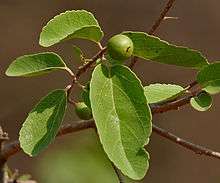Flacourtiaceae
Flacourtiaceae is a defunct family of flowering plants whose former members have been scattered to various families, mostly to Achariaceae, Samydaceae, and Salicaceae. It was so vaguely defined that hardly anything seemed out of place there and it became a dumping ground for odd and anomalous genera, gradually making the family even more heterogeneous.[1] In 1975, Hermann Sleumer said "Flacourtiaceae as a family is a fiction; only the tribes are homogeneous."[2]
In Cronquist's classification, it included 89 genera and more than 800 living species. Of these, many, including the type genus Flacourtia, have now been transferred to the Salicaceae in the molecular phylogeny-based classification, known as the APG III system, established by the Angiosperm Phylogeny Group. In the list below, Salicaceae is defined broadly. Some taxonomists would divide it into Salicaceae sensu stricto, Scyphostegiaceae, and Samydaceae.[3]
- Genera formerly included in Flacourtiaceae (current family in brackets)
|
|
|
References
- ↑ Chase, Mark W.; Sue Zmarzty; M. Dolores Lledó; Kenneth J. Wurdack; Susan M. Swensen; Michael F. Fay (2002). "When in doubt, put it in Flacourtiaceae: a molecular phylogenetic analysis based on plastid rbcL DNA sequences". Kew Bulletin. 57 (1): 141–181. doi:10.2307/4110825. JSTOR 4110825.
- ↑ Miller, Regis B. (1975). "Systematic anatomy of the xylem and comments on the relationships of Flacourtiaceae". Journal of the Arnold Arboretum. 56 (1): 79.
- ↑ Wurdack, Kenneth J.; Charles C. Davis (2009). "Malpighiales phylogenetics: Gaining ground on one of the most recalcitrant clades in the angiosperm tree of life". American Journal of Botany. 96 (8): 1551–1570. doi:10.3732/ajb.0800207. PMID 21628300.
- ↑ Alford, M. H. (2006). "Gerrardinaceae: a new family of African flowering plants unresolved among Brassicales, Huerteales, Malvales, and Sapindales". Taxon. 55 (4): 959–964. doi:10.2307/25065689. JSTOR 25065689.
